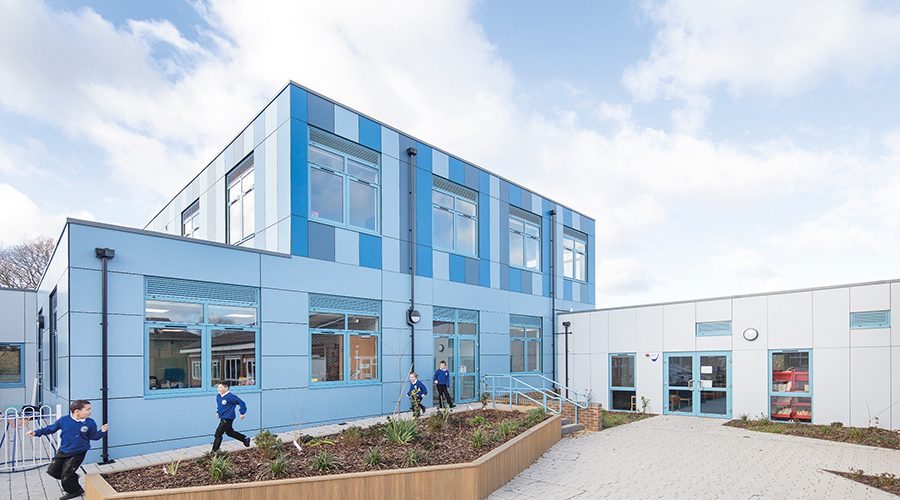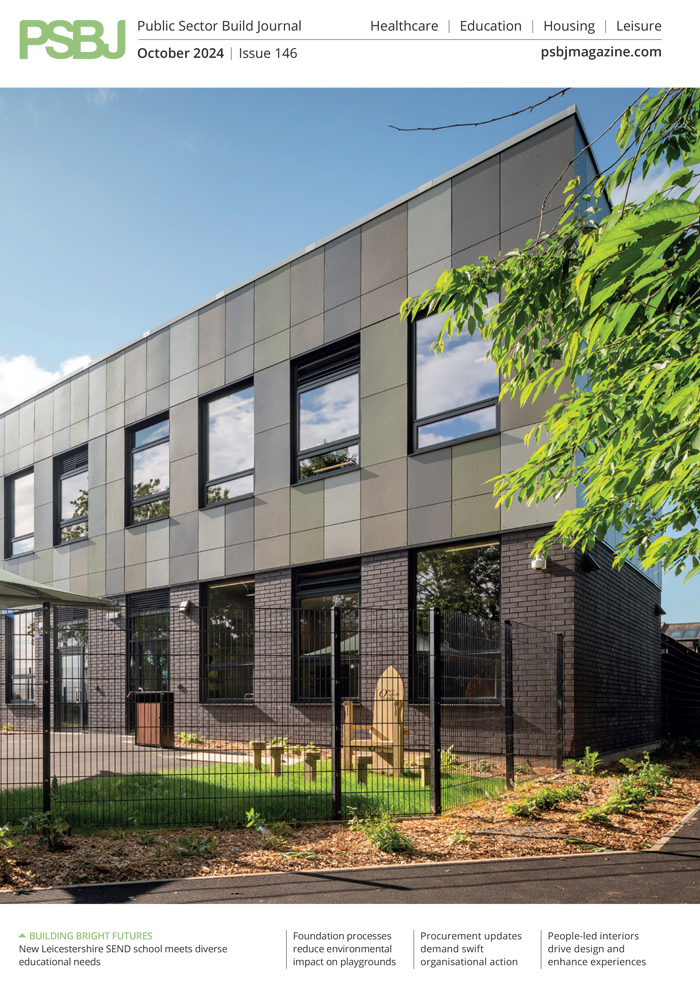In this article, Raymond Millar, Construction Director at offsite specialist, The McAvoy Group, looks at an award-winning school building project and how offsite construction was used to engineer a complex solution.
McAvoy Group
West Hill School is an Ofsted outstanding special school which required new teaching spaces for children with learning and additional needs. These facilities were required to accommodate the school’s conversion from secondary education provision to a two-form entry primary school.
The McAvoy Group was appointed by Surrey County Council to design and build a scheme that would link the traditionally-constructed main building and an existing modular classroom block on a highly constrained, fully operational school site.
McAvoy has a long track record with Surrey County Council, having completed over 40 education building projects in the county – ranging from single classroom buildings to a £5m nursery, infant and junior school extension at Danetree Primary School near Epsom.
The offsite solution
The building for West Hill was manufactured offsite at the Group’s production centre in Northern Ireland. This approach significantly reduced disruption to teaching and ensured the new facilities were ready for occupation on time and after less than eight months on site.
An offsite solution was also developed to build a teacher training centre on the upper floor as West Hill is a Teaching School and National Support School.
Both of the existing school buildings at West Hill remained in use throughout the construction of the new facilities. The offsite approach avoided any interruptions to teaching and the children, despite the site constraints. 28 steel-framed modules were installed in just four days and McAvoy restricted working times to maintain access and accommodate the children’s arrival at and departure from school.
Digitising offsite construction
There is tremendous synergy between offsite construction and the latest digital techniques, which give us the opportunity to radically improve the way we design and produce school buildings.
Harnessing the latest technology allows processes to be streamlined at the earliest stages of a project, to deliver shorter design periods and school buildings that exceed expectations. It allows more effective collaboration internally, with the supply chain and with the school and other stakeholders.
Shorter design periods are critical for offsite construction as manufacturing needs to begin as soon as the ground is broken. To achieve that, detailed design information has to be released to the manufacturing teams at a much earlier stage than with site-based construction – and that necessitates earlier decision making.
BIM allows better client engagement with the use of 3D models. Teaching professionals, for example, are not trained to read 2D construction drawings. If data rich, fully detailed 3D BIM models and virtual reality walkthroughs are used, the design details can be communicated much more effectively to stakeholders, and design options presented for discussion in a far better way.
Addressing site complexities
The West Hill project featured extensive use of digital construction technology to help address the complexities of the site. An offsite solution had to be engineered to accommodate a significant height difference of 870mm between the main school and the existing modular teaching block. Gradient differences were incorporated within corridors using a specially-engineered double floor beam design which also maximised offsite construction.
Challenging ground conditions required complex piled foundations and a supporting steel frame. Here 3D models displayed on tablets on site were invaluable to better inform the groundworks and module installation phases.
Digital construction also facilitated decision making with stakeholders, with the use of 3D models and virtual reality, rather than traditional 2D line drawings. The school was able to see each room and experience the space. It allowed teaching staff to assess how the training centre could work located as a second storey to the new classroom block rather than as a freestanding building which was originally envisaged.
In recognition of its industry-leading application of digital construction technology for the West Hill School project, McAvoy won the RICS BIM4SME Award for Best Virtual Reality BIM.
Designing for children with special education needs
As West Hill is a school for children with special educational needs and located near the M25 motorway network and under a flight path, the building specification demanded outstanding acoustics. McAvoy developed a twin modular wall system and a specially-designed offsite roof solution to achieve the enhanced acoustics. The building was also required to be mechanically ventilated and this equipment had to meet the noise sensitivities of the children.
Other design features of the building to address the needs of learning and additional needs included:
- Wider corridors to help children who have mobility or balance issues
- Hygiene rooms equipped with a hoist to assist children in wheelchairs
- Provision for hoists in two classrooms and for further hoists to be installed in other areas around the new building
- Ease of access between the new building and the existing facilities, and to the external play areas.
The new facilities accommodate a food technology classroom, an open plan library, group rooms and additional classrooms with direct access to the outdoors.
The building has created a covered and controlled link between the main building and the existing teaching block, and a new courtyard provides a secure play area. McAvoy was also responsible for alterations to the school’s existing facilities to accommodate the change from secondary to primary education.
The head teacher’s perspective
Commenting on the project, Judy Nettleton, Head Teacher at West Hill School, said: “The offsite solution generated massive time savings which were invaluable from an educational perspective. The McAvoy team had outstanding communications throughout, and their work was well planned and highly respectful of the challenges we were facing, both as a special needs school and in the transition from secondary to primary education.
“McAvoy was able to accommodate an urgent requirement for an extra floor and our new teacher training facility is a brilliant resource. This space could easily be converted into three additional classrooms if we need to expand capacity in the future. The building has a high level of acoustics which is key for a special school to avoid disruption to children’s education, and the size of the hygiene rooms, the wider corridors and breakout spaces for individual and small
group learning are all invaluable features.”
Giorgia diSarno, Project Manager at Surrey County Council, said: “On this project, offsite construction allowed us to develop a bespoke building with the benefits of better quality control in a factory environment. It was essential to reduce time on site to avoid disruption to the school.
“A shorter construction period on site is hugely beneficial to any school but particularly to special needs children. McAvoy was also able to add value to the project and inform its design by being involved at the project’s inception. This allowed the addition of a further storey.
“Site management on this project was excellent, with good communications with the school which were so important in enabling the teachers to prepare the children. This is vital when carrying out construction works at an SEN school. The finished building is great and was designed according to the special needs nature of the school. Classrooms are light, airy and welcoming.”















